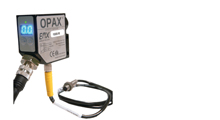|
However, medications are not the only product that can be affected by light. Many consumer products, such as skin care products and even milk, can be affected by light. In a study conducted by VIRGINIA TECH, it was found that exposure to light can rapidly alter the taste, smell and nutritional value of milk, regardless of the type of container it was packaged in. Whether light affects your product ultimately depends on the type of packaging material you use. If you're in one of the many industries that use material types like high-density polyethylene (HDPE) - such as dairy production, gas containers, or personal care products - then using an opacity sensor to evaluate the light transmission of your packaging is an absolute must. Opacity also applies to materials other than HDPE, such as low-density polyethylene (LDPE) and even paper or composite films.
However, opacity sensors offer many more benefits than protecting the package contents. Below, we'll explore the impact a well-designed and well-implemented opacity sensor can have on your business.
How light transmission sensors can strengthen your business:
Increase production speed
Consumer protection comes first, but close behind is the importance of streamlining the manufacturing process. Since you likely need to determine the opacity level of your product packaging, a solution that allows you to quickly and accurately determine where your material stands on a given opacity scale would be extremely beneficial. An opacity sensor integrated into your production line with pass/fail criteria allows for real-time quality control and helps to quickly identify materials or packaging that are not up to par.
Continuity in quality
Many manufacturers constantly monitor performance metrics such as product quality and waste. Since the ability to prevent light damage to package contents is critical to a successful product, it stands to reason that an opacity sensor to automate and improve light transmission measurement in your manufacturing process would enable tremendous strides in improving these metrics.
If you find that an unacceptable number of materials are failing the opacity measurement, it indicates that there is room for improvement in other areas of production that precede this verification phase. And, of course, by identifying these areas and implementing improvements, overall product waste can be reduced.
Turbidity sensors can also be used after production as part of a quality control system. Combined with in-line turbidity detection, this dual approach improves the customer experience and financial performance of your product line by giving you confidence that the products you bring to market meet safety and quality standards.
Easy integration
Not every turbidity sensor is suitable for in-line use in your manufacturing process, and not all integrate deeply with additional systems. The ideal turbidity sensor solution can be integrated into your production environment immediately, eliminating the need to rely on manual and time-consuming processes. Since the sensor will be part of a production or test line, it should also be robust to prevent damage to the internal parts of the sensor and ensure it will continue to work well for years to come.
The Ideal Solution - The OPAX-1000
EMX Industries, Inc. offers the OPAX-1000 OPACITY for a variety of applications where light transmission is critical to production success. The OPAX-1000 displays opacity on a relative scale of 0-99 with an incredibly high discrete output speed of 100 microseconds, providing instantaneous pass/fail responses. If required, the OPAX-1000 also provides a calibration function for manual sensitivity adjustment.
The OPAX-1000 not only optimizes your production process, but is also designed to be incredibly rugged and durable, yet flexible to integrate into your environment. It features a rugged design with adjustable brackets for quick setup.
|




